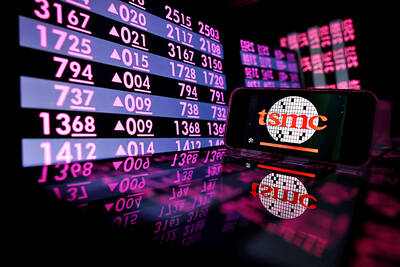Mixed-signal IC and display chip supplier Parade Technologies Ltd (譜瑞) yesterday forecast its business operations this quarter would be flat from last quarter, as strong demand for PCs and laptops offset the effect of the traditional slow season for the electronics industry.
Nevertheless, the fabless semiconductor firm is upbeat for this year, with supply chain inventory adjustments having almost come to an end, and it plans to mass-produce several new products amid resumed demand from clients.
Neihu District (內湖), Taipei-based Parade offers mixed-signal ICs for high-speed interface applications in computers, consumer electronics and display panels. It also supplies embedded DisplayPort (eDP) chips for mobile devices.

Screengrab from the Web site of Parade Technologies Ltd
The company forecast revenue this quarter would reach between US$114 million and US$126 million, it said in a statement released after an online investors’ conference.
Compared with its revenue of US$120.13 million in the fourth quarter of last year, Parade’s revenue guidance for this quarter represents a sequential decline of 5.1 percent in the worst-case scenario or an increase of 4.89 percent in the best.
The company estimated its gross margin would reach between 43 percent and 47 percent this quarter, compared with 43.21 percent the previous quarter, the statement said.
Earnings per share last quarter were US$0.25, compared with US$0.18 a year earlier, it said.
Parade has turned positive on the PC industry’s outlook, expecting notebook computer clients’ pull-in orders to be sustained this year, coupled with a wave of replacement demand.
“Order momentum in the second half of this year would be better than in the first half,” Parade cofounder and CEO Jack Zhao (趙捷) said.
Zhao said the company would begin mass production of both USB4 retimer chips for PCs and PCIe Gen5 retimer chips for servers this year, while its existing timing controllers for tablets with AMOLED (active-matrix organic light-emitting diode) screens have gained orders from several new clients.
With stable demand from new clients and easing inventory pressure, the company expects revenue and earnings to resume growth this year after a slump last year.
Last year, Parade’s revenue fell 35.1 percent to US$441.25 million, the lowest in four years, from US$679.92 million in the prior year, while net profit dropped to US$64.97 million, the worst in five years, from US$167.25 million, the company said.
Earnings per share were US$0.82 last year, down from US$2.09 in the prior year, with gross margin declining 2.8 percentage points to 43.7 percent, it said.
Zhao said that keeping the gross margin stabilized would be a very important task for the company this year.

Taiwan Semiconductor Manufacturing Co (TSMC, 台積電) yesterday said that its investment plan in Arizona is going according to schedule, following a local media report claiming that the company is planning to break ground on its third wafer fab in the US in June. In a statement, TSMC said it does not comment on market speculation, but that its investments in Arizona are proceeding well. TSMC is investing more than US$65 billion in Arizona to build three advanced wafer fabs. The first one has started production using the 4-nanometer (nm) process, while the second one would start mass production using the

A TAIWAN DEAL: TSMC is in early talks to fully operate Intel’s US semiconductor factories in a deal first raised by Trump officials, but Intel’s interest is uncertain Broadcom Inc has had informal talks with its advisers about making a bid for Intel Corp’s chip-design and marketing business, the Wall Street Journal reported, citing people familiar with the matter. Nothing has been submitted to Intel and Broadcom could decide not to pursue a deal, according to the Journal. Bloomberg News earlier reported that Taiwan Semiconductor Manufacturing Co (TSMC, 台積電) is in early talks for a controlling stake in Intel’s factories at the request of officials at US President Donald Trump’s administration, as the president looks to boost US manufacturing and maintain the country’s leadership in critical technologies. Trump officials raised the

‘SILVER LINING’: Although the news caused TSMC to fall on the local market, an analyst said that as tariffs are not set to go into effect until April, there is still time for negotiations US President Donald Trump on Tuesday said that he would likely impose tariffs on semiconductor, automobile and pharmaceutical imports of about 25 percent, with an announcement coming as soon as April 2 in a move that would represent a dramatic widening of the US leader’s trade war. “I probably will tell you that on April 2, but it’ll be in the neighborhood of 25 percent,” Trump told reporters at his Mar-a-Lago club when asked about his plan for auto tariffs. Asked about similar levies on pharmaceutical drugs and semiconductors, the president said that “it’ll be 25 percent and higher, and it’ll

CHIP BOOM: Revenue for the semiconductor industry is set to reach US$1 trillion by 2032, opening up opportunities for the chip pacakging and testing company, it said ASE Technology Holding Co (日月光投控), the world’s largest provider of outsourced semiconductor assembly and test (OSAT) services, yesterday launched a new advanced manufacturing facility in Penang, Malaysia, aiming to meet growing demand for emerging technologies such as generative artificial intelligence (AI) applications. The US$300 million facility is a critical step in expanding ASE’s global footprint, offering an alternative for customers from the US, Europe, Japan, South Korea and China to assemble and test chips outside of Taiwan amid efforts to diversify supply chains. The plant, the company’s fifth in Malaysia, is part of a strategic expansion plan that would more than triple